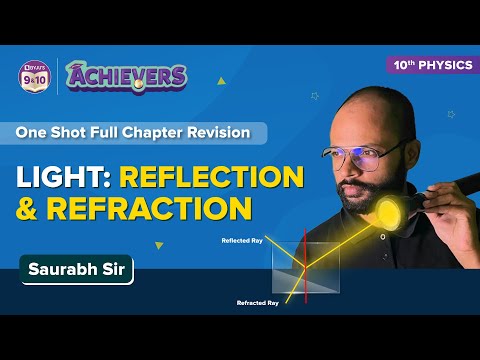The lens is a thin transparent transmissive optical material that disperses or focuses a light beam through refraction. Lens has the power to converge or diverge the light. A simple lens features only one piece of transparent material, and compound lenses feature more than one simple lens. Lenses are used in various optical devices like microscopes, telescopes, binoculars, cameras, and magnifying glasses.
Lens formula is given by:
where,
v = the distance of the image from the lens.
u = the distance of the object from the lens.
f = the focal length of the lens.
The lens formula gives the relationship between the distance of an image (v), the distance of an object (u), and the focal length (f) of the lens. The lens formula is applicable for concave lenses and convex lenses.
Read more: Lens Formula
Watch the video and revise all the important concepts in the chapter Light Reflection and Refraction Class 10

Important Lens Formula Questions with Answers
1. Which of the following is also known as a diverging lens?
- Convex lens
- Concave lens
- Plane mirror
- Bipolar lens
Answer: a) Convex lens
Explanation: The diverging lens is also known as the convex lens.
2. Is the lens formula applicable to convex lenses?
- YES
- NO
Answer: a) YES
Explanation: Lens formula applies to concave and a convex lenses.
3. What does ‘v’ represent in the lens formula?
- Distance of the object from the lens
- The focal length of the lens
- Distance of the image from the lens
- None of the options
Answer: c) Distance of the image from the lens.
Explanation: ‘v’ represents the distance of the image from the lens.
4. Lens formula is given by _____
- \(\begin{array}{l}\frac{1}{f}=\frac{1}{v}*\frac{1}{u}\end{array} \)
- \(\begin{array}{l}\frac{1}{f}=\frac{1}{v}+\frac{1}{u}\end{array} \)
- \(\begin{array}{l}\frac{1}{f}=\frac{1}{v}-\frac{1}{u}\end{array} \)
- \(\begin{array}{l}2f=\frac{1}{v}-\frac{1}{u}\end{array} \)
Answer: c)
Explanation: Lens formula is given by
Where, v – is a distance of an image, u – is the distance of an object and f – the focal length.
5. Lens formula relates to _____
- Focal length
- Image distance
- Object distance
- All the above options
Answer: d) All the above options.
Explanation: The lens formula relates object distance, image distance and focal length.
6. The point on the principal axis at the centre of the lens is called _____
- Optical Centre
- Principal axis
- Aperture
- Focus
Answer: a) Optical Centre
Explanation: The optical centre is the point on the principal axis at the centre of the lens.
7. Which lens is used in compound microscopes?
- Convex lens
- Concave lens
- Mirror
- Both concave and convex lenses
Answer: d) Both concave and convex lenses.
Explanation: Compound microscopes use both concave and convex lenses.
8. State true or false: Mirror can be curved.
- TRUE
- FALSE
Answer: a) TRUE
Explanation: Mirror can either be plane or curved.
9. The power of the lens is the reciprocal of its _____
- Optical Centre
- focal length
- Principal axis
- Aperture
Answer: b) focal length
Explanation: The power of the lens is given by the reciprocal of the focal length of the lens.
10. Define the aperture of the lens.
The area of the lens ideal for refraction is known as the aperture. The aperture of the lens is the effective diameter of its light-transmitting area.
Practice Questions
- Define lens.
- What are the types of lenses?
- What is a convex lens?
- Which device uses a concave lens?
- What is the lens formula?
Watch this exciting video that explains how spectacles help correct the refractive errors of the human eye

Stay tuned to BYJU’S and Fall in Love with Learning!
Comments